Nowadays children are only familiar with vegetables from the supermarket: sorted, packaged, and unfortunately, sometimes not even tasty. This might have to do with increasing urbanization. Children that live in cities don’t have much contact with nature anymore, never mind agriculture. But things are not as bad as they might seem at first glance – there are countless ways to bring gardens into the city or even into your apartment. Here we introduce some of those possibilities.
Sustainable, regional, seasonal – these are the current trends. Urban gardening falls into this category. But although everyone is talking about these concepts right now, they are by no means new. Urban gardening goes back to the 19th century. While healthy nutrition is the main focus today, back then urban gardens were important for the segment of the population that had no food at all; at that time, allotment gardens were established as a charitable service for impoverished people.
Schreber gardens
Daniel Gottlob Moritz Schreber, after whom the Schreber gardens are named, didn’t have one of these small gardens himself (and he would certainly have been surprised by the volume of garden gnomes to be found there in the meantime), but he did point out that on the heels of urbanization, children and young people would benefit from physical activity outdoors. Places were set up for children to play and practice their tumbling – and later, for their parents to plant gardens: The Schreber garden was born. These gardens not only offered the urban population a refuge from the concrete jungle and a place to grow plants, but they also provided a way for the people to survive the food shortages during the two world wars.
Community gardens
Due to the housing shortage, residential space is more and more frequently taking over the areas used for allotment gardens, but in turn, the establishment of community gardens is increasing – from district and neighborhood gardens to intercultural gardens. Most often these gardens are planted in outdoor municipal spaces that are not currently in use. What all of these types of gardens have in common is that they are not used commercially and, for the most part, they are public. People not only plant vegetables here, but they also get to know their neighbors and do things together, which gives the city a new feel, to a certain extent. However, there are countless other reasons to create gardens in an urban environment.

Mindful eating
Healthy nutrition plays a role in the lives of more and more people. Growing food crops gives agriculture more visibility on one hand and makes it easier to experience on the other. Urban gardeners get a feeling for the processes that are part of food production and examine them critically and, as a result, they have a greater understanding of what food producers do. The appreciation for food they grow themselves increases, together with their knowledge of healthy food – from fruits, vegetables, and herbs to edible flowers. They have the experience of eating based on the seasons, right in their own, local district garden. Those who aren’t able to afford healthy food for financial reasons have the option to grow it themselves.
Ecology
Food products often undergo a long journey from grower to consumer. This results in increased CO2 emissions, more trucks on the highways, traffic jams, and noise. All of these problems are eliminated when food is supplied by a local urban garden: whatever is harvested is usually used right away and it doesn’t have to be transported, stored, or refrigerated. And there’s no packaging either. Urban gardeners are thrifty with resources, they use water collected in rain barrels and fertilizer made from natural sources, and they grow their fruits and vegetables in harmony with nature (see also the section on "Permaculture").
Recreation and health
Recreation is a substantial part of urban gardening, even if the gardens are loosely distributed across the city: When a person is surrounded by an abundance of green plants, whether on the balcony or just outside the front door, it’s easier to forget the stress of everyday life. Gardening involves exercise and fresh air, which enhance a gardener’s health and the mind switches automatically to other thoughts. Quality of life increases when people can relax among lush greenery – especially during those times when one feels redundant at work. There are no obligations with urban gardening; people can do it when it fits into their own schedules.
Closely related is the experience of nature that gardeners can have right where they live – often in unused spaces that would otherwise remain fallow. People can experience how plants become the foods that are later found on the shelves of vegetables in stores, but in this case, they participate directly in that process by sowing or planting and harvesting – so that the resulting crops can then be eaten. In this way, gardeners develop a sense of how food production works, of the various factors and forces it depends on, and how quickly this system can fall out of balance.
Another aspect to consider is that having plants in living spaces or in the city benefits us. In our biology classes at school we learned that plants provide fresh air: They take in CO2 and transform it into oxygen, among other elements. So the more plants, the better. During a hot summer they regulate the climate because, due to increased evaporation, they provide a cooling effect. Large plants also supply shade. Therefore, plants contribute to temperature compensation in various ways. Moreover, plants retain dust.
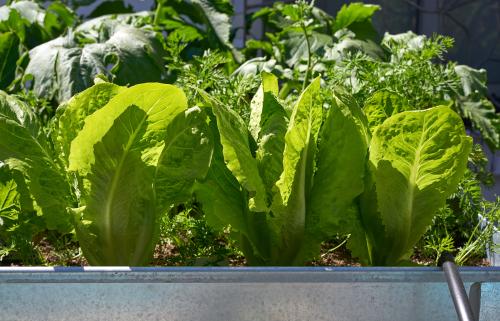
Numerous planted areas break up the dreary gray of the buildings, lighten up a city’s appearance, and ultimately have a positive effect on the image of the respective city district. Cities with especially large amounts of trees edging the streets, with parks, urban gardens, and boulevards provide their residents with a new quality of life.
Involvement and inclusion
Urban gardens provide a fantastic possibility for people to get involved in their own district and contribute to its development. This strengthens the feeling of belonging and commitment to their own, home environments, particularly because they identify with these places more strongly. In addition, they not only produce food for their own use, but they also feel like they are helping to shape their local district and, in certain ways, to participate in decisionmaking. They can experiment and be creative in "their" gardens; their self-confidence grows when, in a few weeks, they see and taste the initial results of their work.
Urban gardens offer space for interaction and create possibilities to get to know others in passing. Because everyone can participate, people who would normally not meet each other can develop relationships. People of all nationalities, ethnic backgrounds, and social classes can come together in an urban garden. In this way, those involved not only get to know their neighbors better, but they can also share their knowledge and experiences. In addition, they develop understanding for one another because their encounters occur in everyday situations in which it’s easier to ask about behaviors that are not self-explanatory.
As early as the 1990s, international gardens provided places for people from a wide variety of cultures to meet. This contributed to more than mutual understanding – immigrants had an opportunity to feel more at home in a foreign country by planting crops from their native countries. This way, they had something from their homeland close by. This gave them a kind of sovereignty and esteem. The same is true for city dwellers who have less financial means: In an urban garden they can share their knowledge with each other and immerse themselves in creating something. These people both harvest the fruits of their labor and gain recognition for what they have produced. In the meantime, more and more groups, including artist initiatives, are discovering urban gardens for themselves.
Edible city
As with all of the categories listed here, it is difficult to characterize or classify the general term "urban gardening" because there are no specific definitions. The main difference between an edible city and urban gardening is that although an edible city, like community gardening, refers to a public space, urban gardening is more often a private endeavor. The first initiative in the area of an "edible city" started in 2008 in Todmorden, England. It was called “Incredible Edible.” The idea was to bring people of all ages, income levels, and cultures together, specifically with regard to a subject that interests everyone: eating. The motto of the initiative was "If you eat, you’re in." The goal was to achieve something through many small actions. And the citizens of Todmorden certainly succeeded in that. Plants can now be found in every corner of the city. Moreover, it is a popular tourist destination.
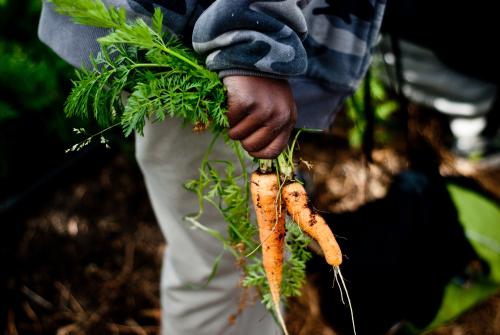
Today there are edible city projects in many cities around the world. Increasingly, instead of just ornamental plants, agricultural crops are being grown in public spaces: fruiting shrubs, vegetable patches, herbs in raised beds or vertical arrangements – at the edges of playgrounds, in front of physicians’ practices, in pedestrian zones, and on and on. In most instances, the principles of "permaculture" are followed. City residents are specifically urged to participate – and naturally to pick and eat the produce. This turns them into "prosumers" (a portmanteau word that combines "producer" and "consumer").
Initiatives like this not only expand local food supply, but city residents also literally develop a taste for getting involved, making their city greener, eating healthier, and becoming more environmentally conscious.
School gardens
More and more schools and child care centers are moving toward teaching children about nature even at a very young age. Gardens at schools or child care centers provide kids with their first gardening experiences. This way, they can engage in learning about a world of plants that excites all of their senses: They see the green plants or the various colors of fruits and vegetables; they smell them, they can feel their textures, and of course, they can also taste the produce. There is also something to hear: namely the bees that they attract with the crops they plant. This active experience in nature leaves a long-lasting impression: The children can try things out; they take on responsibilities, either alone or together with their teachers or caretakers – depending on their age – from planting seeds to harvesting. They create something together and notice that they are more self-confident. And above all, they learn how good something tastes when they grow it themselves. This makes the garden part of the pedagogical design.
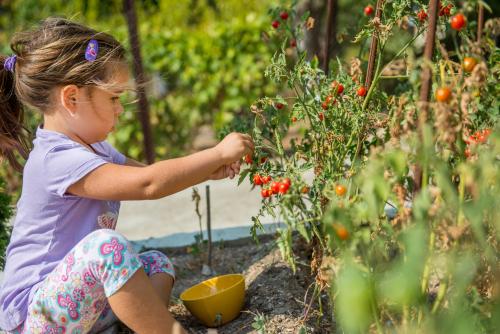
Permaculture
The term "permaculture" combines the English works "permanent" and "agriculture" to designate a sustainable form of farming. But it includes more than agriculture and gardening alone – in fact, it refers to practicing self-sufficiency with regard to food in harmony with nature and using systems that are either entirely natural or that imitate natural processes. The goal is to protect resources, to reduce energy consumption, and to accumulate less consumer goods overall.
All gardeners who would like to implement the concepts of permaculture should understand a great deal about the soil they are using for cultivation: what can be planted there and in which form, the processes used for garden maintenance, the best fertilizers, etc. When laying out the garden, the alignment of the property with respect to the course of the sun should be observed along with the expected wind conditions. These factors are taken into consideration when crops are planted – some like it sunny, others prefer shade, and still others require calm wind conditions. Using natural fertilizers when planting the beds protects the soil and contributes to nutrient cycle regulation. Planting takes place based on seasonal calendars. This achieves high yields without making things too expensive. And it is also sustainable and ecological. As a side effect, gardeners become very familiar with local plant species.
They select types of vegetables that correspond with the climate conditions on one hand and the soil on the other. The various plants should be combined such that they have positive effects on each other. For example, basil is planted with tomatoes or cucumbers because it repels mildew. A garden cultivated based on the principles of permaculture should not contain monocultures. Mixed cultivation and biodiversity are required instead. Many different types and species thrive next to each other. Often, gardeners purposely plant older or rare types in order to contribute to the conservation of species.[1] But not only that: A variety of plants also provides bees and other insects with food, a practice that has been severely neglected by modern agriculture, which relies mainly on monocultures. Bees need a diverse range of foodstuffs consisting of many different types of plants and pollen. Gardens in which mixed cultivation abounds also have a greater resistance to problems and are less frequently plagued by pest infestations or diseases.
A rain gutter or rain barrel for rainwater collection is an integral part of each permaculture garden – in this way, gardeners contribute to the prudent use of the Earth's water resources. The compost heap ensures the availability of natural fertilizer. A greenhouse is quite practical for making sure that even sensitive plants survive the winter and that hobby gardeners can cultivate seedlings early in the season. It can be positioned to take advantage of circumstances, for example, near a pond that reflects the sun, which radiates additional heat. Also beneficial is a root cellar, where harvested fruits and vegetables can be stored without a refrigerator. This saves energy and reduces electricity costs. And insecticides are not necessary when useful animals such as chickens or geese are part of a permaculture garden.
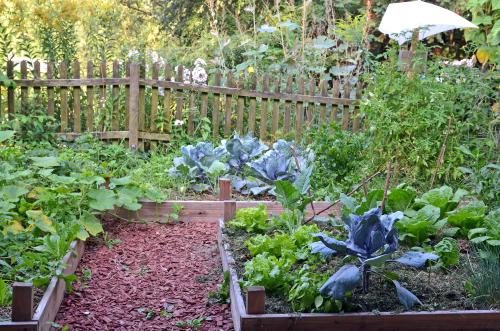
Potato barrel
Those with small gardens who still do not want to go without home-grown potatoes should consider planting a potato barrel or tower. The advantage here is that cultivation is not horizontal, but instead vertical. The potatoes are planted in layers. This generates a high yield in a relatively small area. A potato barrel is easy to build, doesn't cost much, and there's even room for it on a balcony. Instructions can be found online. If old tires are available, they can be stacked up and used to plant a potato tower as well – a person just needs a little imagination.
Balcony gardens
A balcony garden is a green oasis that can be enjoyed at any time. Everything discussed up to this point regarding other types of gardens applies to balcony gardens as well – just on a smaller scale. As we have seen, even potatoes can be planted on a balcony. Even if the yield isn't as great as in a Schreber garden, for example, gardeners look forward even more to the juicy tomatoes that they have seen growing right in front of the living room window.
Herbs are often cultivated in balcony gardens – this way, fresh herbs are always available right there and a person doesn't have to buy the small packages from the supermarket where the contents are often already wilted by the next day. Growing a plant does take significantly more time than going to the supermarket, but the harvest can be enjoyed over a much longer period. While the plants bought from the store are thrown away after they are used, a gardener's own herbs on the balcony last much longer and regrow – and just the right amount can be used. This way, people don't need to buy a whole bunch when they just need a little bit.
Hydroponics
A new, future-oriented trend known by the English term "hydroponics" involves cultivating plants without soil. This can be done either in a person's own garden or indoors – or even on a large scale in a spacious production hall. Hydroponics offers gardeners many advantages: This method does not depend on the seasons or the weather, which means vegetables can also be grown at off-peak times. The plants grow more quickly because gardeners can adapt the conditions accordingly. Plant diseases associated with the soil, such as gray mold or clubroot, are completely eliminated.
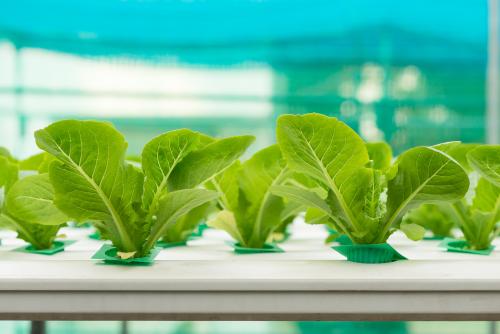
Especially larger producers can save money with hydroponics because it significantly reduces water and nutrient consumption. Both can be applied precisely, whereas in gardens that use conventional cultivation, the soil stores the water and delivers the nutrients, so the water and nutrients seep away to a great extent – or the water evaporates due to the radiation of the sun.
Another advantage that large producers have is that they can align cultivation with the consumers' current needs, so they can react relatively quickly to spontaneous preferences and requests because hydroponic plants grow significantly faster.
Aquaponics
Another promising trend is aquaponics, which can be described as a symbiosis of fish and plants. In this ecological cycle, fish and plants work together and benefit from each other. The Maya used a similar system, and now, thanks to advanced technology, it is experiencing a revival: The unit consists of two tanks – with freshwater fish swimming in one, while the other is used to water the plants. The two tanks are connected with each other so that the excrement of the fish can be used to fertilize the plants (this is done by adding bacteria). In turn, the plants ensure that the water in which the fish are swimming is cleaned. This process is very environmentally conscious because the water in the fish tank neither needs to be cleaned nor do the fish need to be provided with antibiotics. Moreover, the plants do not require the use of plant protection products.
The advantage of this system is that it can be used anywhere in a city: on a rooftop or, on small scale, even on a gardener's own balcony. This eliminates long transportation routes. However, even though the system is ecological and environmentally friendly, the vegetables cannot be designated as "organic" because according to the EU directives, organic vegetables must be grown in soil.
The United States is the global market leader in the area of aquaponics.
Vertical gardens
Because urban properties are becoming increasingly scarce and expensive, architect and botanist Patrick Blancs came up with an idea to grow plants in vertical arrangements, such as on building facades. Not only does this look beautiful and provide urban dwellers with a greater quality of life – like every other garden, vertical gardens also improve air quality. And moreover, it reduces energy consumption: Buildings with outer facades designed to include gardens are cooler in summer, while in the winter, the plants provide a layer of insulation and protect the building from the cold. Furthermore, no matter what the season, vertical gardens offer protection from urban noise pollution.
© pierluigipalazzi – adobe.stock.comA well-known project in this area is Bosco Verticale in Milan: The two skyscrapers that form this "vertical forest" are covered with lush green plants: mosses, grasses, perennials, conifers, and even deciduous trees. The facade of the building accommodates a total of 900 trees – and 11,000 plants. If they had been planted on a horizontal rather than a vertical surface, they would have encompassed an area of 7,000 square meters. And the amazing thing is that just 5 percent of the construction costs were associated with the plants – a fact that encourages further projects of this type.
One of these will soon be built in Hamburg: An enormous bunker reminiscent of the Nazi period will be covered with an abundance of green plants across three storeys: A Zen garden is planned for the rooftop terrace, a mountain path will be built below, and on the tier in between there will be areas for people to garden. Increasingly, other cities are also promoting rooftop and facade greenery.
Hobby gardeners can also get involved in vertical gardening by planting a wall garden on the balcony or even inside the apartment or house, for example. What's important here is to leave enough room between the wall and the plants so that mold cannot grow. The best choice for balconies are local or indigenous plants that can take the wind and weather. Those who decide to create a vertical balcony garden not only increase their own quality of life, but also that of their neighbors.
Rooftop gardens
The effects of rooftop gardens are similar to those of vertical gardens: They ensure that the rooms directly beneath the roof do not get too hot due to solar radiation during the summer; in the winter, the layer of insulation they provide conserves heat. In addition, they supply noise protection. Primarily flat roofs, but also some pitched roofs, can be transformed into flourishing green spaces that are not only economical, but also ecological: The plants that grow here filter damaging substances out of the air and retain dust. No matter if a gardener has a rooftop garden or a green roof: both improve urban life and offer birds, insects, and many other tiny creatures a green oasis in the middle of the city. And people can also relax in their rooftop gardens at the end of the workday and have someplace to retreat from the stress of everyday life.
Rented gardens
Those who do not have a balcony or (Schreber) garden to call their own, but still want to grow and harvest their own fruits and vegetables now have the option to rent a garden. Most of these gardens are located at the edges of the city and can be easily reached from the gardener's own residence. In many cities, start-ups are making it easy for hobby farmers to rent gardens and tend and harvest them on their own: The gardens are already prepared when the renter takes over. Most often the fruits and vegetables are already planted – the renter simply has to maintain the garden. Fertilizer and garden tools for these tasks are provided. Renters often also receive digital newsletter which explains what to do, step by step – always according to the season.
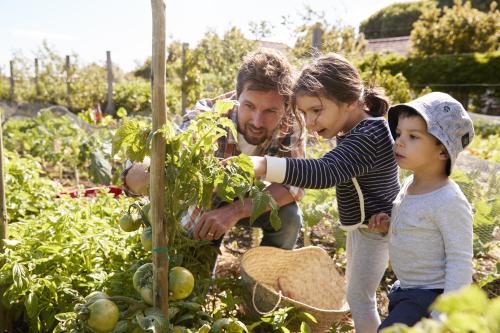
Those with a passion for gardening can rent a patch, mostly just for one season, to try it out and how well they manage. Many people are enthusiastic about rented gardens: They can experience nature there and feel connected to the earth as they root around in it. Relaxation sets in automatically, even though garden work can definitely be strenuous. They harvest regional and seasonal vegetables that are pesticide-free, and by harvesting the garden themselves, they regain some of their own sovereignty by becoming somewhat independent from the supermarket around the corner.
Professional agriculture in the city
Because cities are constantly growing and metropolitan areas continue to expand, areas that were previously rural – along with agricultural land – are becoming urbanized. Agricultural enterprises are taking advantage of this trend by providing city dwellers with additional, attractive offerings: Among others, they are establishing restaurants and farm stores with freshly harvested products. Most of these are well-frequented.
The growth of cities presents not only an opportunity for agricultural enterprises, but also a challenge because in large metropolitan areas such as the Ruhr region, agricultural land is becoming scarce; as urbanization occurs, crop production area is lost. Options for further development are severely limited. Those involved in agriculture here are thinking about solutions. One is increasing the use of fallow land located in the city for producing food within the city itself – which creates a so-called urban patchwork landscape.
Community-supported agriculture
Community-supported agriculture (CSA) does not fall into the category of urban gardening, but it is a future-oriented and sustainable model for supplying food, and not just for the urban population. In this model, farmers and private households come together to form an economic community: A number of families join together and finance the products of an agricultural enterprise in advance – in return, they receive the entire harvest. In this model, all of the participants share the responsibility as well as the risk (incurred in a poor harvest due to bad weather, for example).
The advantage of this model is that farmers gain planning security and are no longer forced to adhere to a market orientation – which demands a great deal from both them and their animals and obligates them to take measures that are not consistent with nature-based agriculture. Such measures only secure survival – it's hardly about whether or not the farmer, the animals, and the environment benefit. In a community-supported agriculture system, agricultural enterprises do not depend on subsidies, so their livelihoods are no longer threatened – they have a secure income. This gives them the option to use farming practices that are natural and healthy. The advantage for customers is that they receive the harvest, which consists of seasonal and regional foodstuffs, some of which are products that require further processing, such as cheese or bread, if the enterprise offers that. This establishes a transparent economic cycle that is no longer dependent on the market. In this way, the participants are able to eat healthy food and, as a side effect, contribute to the conservation of nature.
Guerilla Gardening
The first community gardens planted on unused land in New York during the 1970s are considered as precursors of the guerilla gardening movement. This term refers to the unregulated sowing of seeds and planting of crops anywhere in urban areas. These activities originally began as a political movement that opposed some the trends in urban development and are considered to be at the margins of legality. Planting vegetation in municipal areas without permission is actually considered a misdemeanor. However, municipalities usually tolerate such actions because they make the city more beautiful overall and give it a friendlier appearance and, in general, such protests are conducted peacefully.
Guerilla gardeners often use seed bombs that they throw into desolate residential areas, for example, because from their perspective, public spaces belong to all residents and the city should not have complete sovereignty over them. Seed bombs are practical because it's easy for people to make them themselves: simply mix some soil with some clay, place flower seeds inside, shape the whole thing into a ball, then moisten it and allow it to dry – and the seed bomb is finished. Due to the nutrients and the moisture within, it will germinate and flourish magnificently, even in poor conditions. During the warmer months, the bombs are distributed wherever it can't hurt to have some beautiful, blooming flowers – and just a few weeks later, the area is not only a feast for the eyes, but also a paradise for bees and butterflies. Those who want to try this should make sure to use regional, indigenous types of flowers that will not disturb our ecological system and are not poisonous.

Moss graffiti is also popular – it can be used in a person's own garden, for example. To make moss graffiti, use a blender to mix indigenous moss species with yogurt, beer, and sugar. Then use a brush to paint the mixture onto a wall or stonework where it remains cool and moist even during the summer. Afterward, spray the graffiti with water frequently so that it grows. With a bit of luck, this will create a beautiful and lasting decoration that is completely natural. Because moss does not have any roots and takes in moisture directly through its leaves it can thrive beautifully in these conditions.
QUADRO nature
We at QUADRO find the trends described here extremely exciting – particularly because we think it is important for children to have opportunities to come into contact with nature easily and in a playful way. Our construction kits are already designed to promote the natural and healthy development of little ones. Now we want to go a step further and introduce new products based on well-substantiated knowledge and that not only children will use.
See you soon with QUADRO nature!

↑ The Food and Agriculture Organization of the United Nations estimates that about 75% of crop species disappeared forever during the previous century.
Plants make us healthier
Indoor plants are not only decorative, they also provide many healthy benefits. Through the process of photosynthesis, they provide oxygen during the day and they also purify the air. Because they dispense tiny amounts of water into the environment, they also increase the humidity in the room, which has a positive effect on dry skin. They also help prevent colds and sore throats. Potted plants can also be used after operations as a complementary medicine treatment because they decrease the sensation of pain and reduce fear and tiredness. Patients with plants in their rooms recover more quickly than those in austere surroundings. Moreover, when plants are in the workplace, employees do better work: Their concentration improves, they are more productive, and they can remember things better.
Sources
- Gemeinsam gärtnern in der Stadt. Praxisbeispiele aus Nordrhein-Westfalen. Ministerium für Klimaschutz, Umwelt, Landwirtschaft, Natur- und Verbraucherschutz des Landes Nordrhein-Westfalen, Referat Öffentlichkeitsarbeit. April 2016
- Aquaponik - ein vorbildliches System - FUTURE - ARTE
- What Is Hydroponics And How Does It Work? Agriculture Academy. 21.09.2020
- Verena Schmidt. Permakultur. Mein schooner Garten, 10.03.2019
- Vertikaler Garten: Es grünt so grün. Urban Gardening für engsten Raum: Tipps für Vertical Gardening. Stadtwerke Düsseldorf
- Wolf-Christian Fink. Vertikale Gärten: Das wächst zum Himmel. Future Briefings. Das Zukunfts-Magazin vom Jahreszeiten Verlag, 02.2017
- Hillegarden
- Gemüse und Kräuter auf dem Balkon anbauen, Tipps vom Gemüse-Gärtner - Balkongemüse, urban gardening
- Kleine Einführung in den deutschen Schrebergarten. Meet the Germans. Deutsche Welle
- Monokulturen - eine Bedrohung für Wild- und Honigbienen
- Der Trend zum bepflanzten Dachgarten. Homesolute.com
- Maria Hohenthal. Kartoffelturm selber bauen: Für Balkone und kleine Gärten, Utopia, 07.06.2020
- Sarah Brockhaus. Essbare Städte: So funktioniert das Konzept, 03.11.2019
- Pam Warhurst. How we can eat our landscapes. TEDSalon, 2012
- Schulgarten-Unterricht: Wie Kinder im Garten lernen | MDR Garten
- Meine Ernte
- Justin Amaral. Samenbomben DIY: Hol dir den 'Guerilla Gardening'-Trend nach Hause. Gofeminin, 24.07.2019
- Aktion: Moos-Graffiti. UND JETZT RETTEN WIR DIE WELT! 27.10.2021
- Rolf Born. Projekt Zukunftsforum Urbane Landwirtschaft, 09./10.12.2014
- Projekt „Zukunftsforum Urbane Landwirtschaft“. Landwirtschaftskammer Nordrhein-Westfalen
- Was ist Solidarische Landwirtschaft?
- 5 Health Benefits of Houseplants
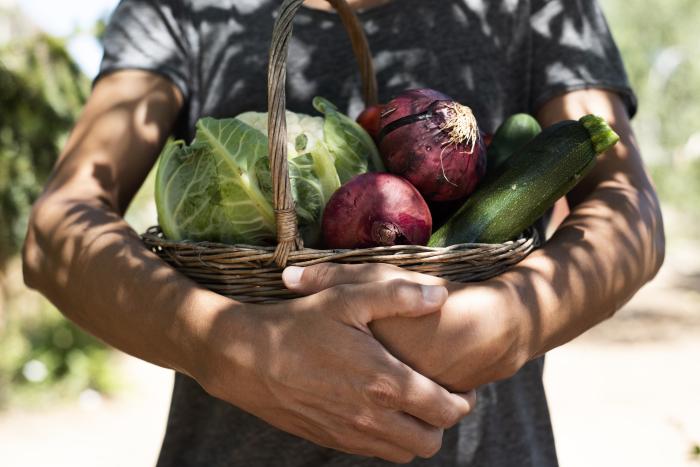
コメント